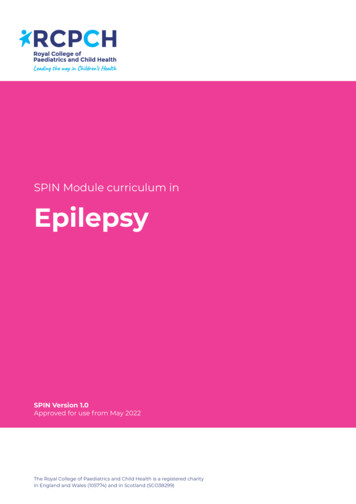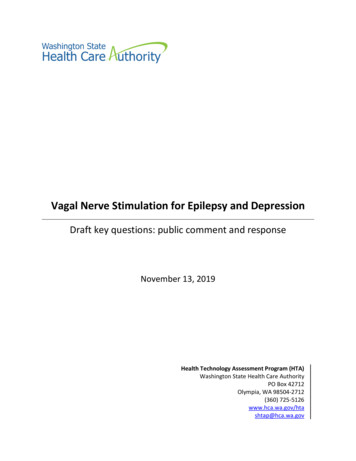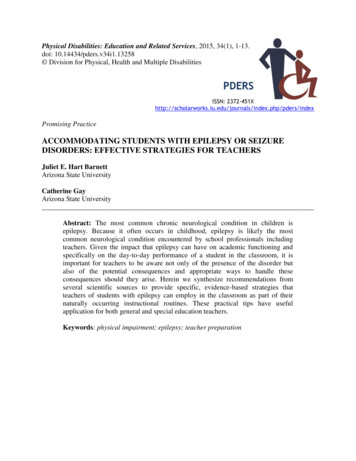
Transcription
Physical Disabilities: Education and Related Services, 2015, 34(1), 1-13.doi: 10.14434/pders.v34i1.13258 Division for Physical, Health and Multiple DisabilitiesPDERSISSN: .php/pders/indexPromising PracticeACCOMMODATING STUDENTS WITH EPILEPSY OR SEIZUREDISORDERS: EFFECTIVE STRATEGIES FOR TEACHERSJuliet E. Hart BarnettArizona State UniversityCatherine GayArizona State UniversityAbstract: The most common chronic neurological condition in children isepilepsy. Because it often occurs in childhood, epilepsy is likely the mostcommon neurological condition encountered by school professionals includingteachers. Given the impact that epilepsy can have on academic functioning andspecifically on the day-to-day performance of a student in the classroom, it isimportant for teachers to be aware not only of the presence of the disorder butalso of the potential consequences and appropriate ways to handle theseconsequences should they arise. Herein we synthesize recommendations fromseveral scientific sources to provide specific, evidence-based strategies thatteachers of students with epilepsy can employ in the classroom as part of theirnaturally occurring instructional routines. These practical tips have usefulapplication for both general and special education teachers.Keywords: physical impairment; epilepsy; teacher preparation
Hart Barnett and Gay2IntroductionMrs. Johnson was in the middle of a reading lesson in her inclusive 3rd grade class when one ofher students shouted out, “I think there might be something wrong with Bobby!” Sure enough,when Mrs. Johnson approached Bobby he was staring blankly ahead, blinking rapidly, andsmacking his lips together. Attempts to draw Bobby out of his seizure were unsuccessful.Mr. Smith was monitoring his 6th period general education algebra class as they took a math test.All of a sudden, from the back of the room he heard a loud bang. When he looked back, he sawSusie lying on the ground; her arms and legs were stiffening and jerking. The other students inthe class were clearly confused and shocked by the situation and had no clue how to react.These scenarios are examples of two possible ways that epilepsy or a seizure disorder maymanifest itself in a classroom setting. Would you know how to handle such situations?The most common chronic neurological condition in children is epilepsy. Epilepsy is a conditioncharacterized by recurrent and unprovoked seizures, which are temporary neurologicalabnormalities that result from unregulated electrical discharges in the brain (Shorvon, Guerrini,& Andermann, 2011). Seizures occur when abnormal neuron firing within the brain causes asudden change in cerebral function. According to the Centers for Disease Control and Prevention(CDC; www.cdc.gov) about 2.3 million people in the United States (about 1 in 100) haveepilepsy. One in 26 individuals will develop this condition at some point in his/her lifetime. TheCDC further reports that children under the age of two are especially vulnerable to the condition.Among children, the prevalence of seizures is around four to eight in every 1,000 children.Epilepsy onset most commonly occurs either before the age of two or around the onset ofpuberty (Black & Hynd, 1995) with 30% of cases occurring by the age of five and 75%occurring by the age of 20 (Barrett & Sachs, 2006). Because it often occurs in childhood,epilepsy is likely the most common neurological condition encountered by school professionalsincluding teachers (Barrett & Sachs, 2006).It is important to note that seizures and epilepsy are not synonymous. An epileptic seizure is atemporary occurrence of signs and/or symptoms due to abnormal excessive or synchronousneuronal activity in the brain. Epilepsy is a disorder characterized by a long-term predispositionto generate epileptic seizures and by the neurobiological, cognitive, psychological, and socialmanifestations of this condition. That is, a seizure is a singular event and epilepsy is thecondition involving recurring, unprovoked seizures (Epilepsy Foundation, 2014).Seizures are classified as either partial or generalized (Spiegel, Cutler, & Yetter, 1996). A partialseizure typically begins at a specific site in the brain and impacts only one side of the brain.Partial seizures may result in impaired consciousness (complex) or not (simple). Unlike partialseizures, generalized seizures affect both hemispheres of the brain. Generalized seizures can beclassified as tonic-clonic or absence seizures. Tonic-clonic seizures are associated with repetitivestiffening (tonic) and jerking (clonic) of the extremities while absence seizures involve a lapse inconsciousness without significant motor movements (Fisch & Olejniczak, 2006). Absenceseizures are often described as brief staring episodes and may occur several times throughout theday (Benbadis & Berkovic, 2006). Other generalized seizure types may also occur, including
Physical Disabilities: Education and Related Services, 34(1), 1-133myoclonic seizures, which consist of sporadic jerks, usually on both sides of the body, and atonicseizures, which consist of a sudden and general loss of muscle tone, particularly in the arms andlegs, often resulting in a collapse (Spiegel et al., 1996). Generalized seizures can result in aperiod of confusion and semi-consciousness known as the post-ictal period (Barrett & Sachs,2006). During this period, children may especially struggle with tasks involving attention,learning, and memory (Wodrich, Kaplan, & Deering, 2006). A graphic depicting seizure typesand subtypes is provided in Figure IC-CLONIC No loss of consciousnessMay include rhythmicmovements or sensorysymptomsUsually lasts less than 1minuteCOMPLEXPartial Includes loss ofconsciousnessMay include a fallIncludes convulsionsGenerally last 1-3 minutesABSENCE Impaired awareness andability to respondRepetitive and nonpurposeful movementsOften lasts 1-3 minutes Brief loss ofconsciousnessAppear as "staring spells"Symptoms of confusionor “daydreaming”Usually lasts 1-10secondsFigure 1. Graphic representation of seizure types and subtypes.Three particular characteristics of epilepsy that may disrupt a child’s learning process include theseizure activity itself, cognitive deficits associated with the area of the brain affected by theseizures, and side effects of anti-epileptic drugs (Wodrich et al., 2006). Impairments associatedwith actual seizure activity can lead to missed instruction, general slowed cognitive functioning,limited awareness, and memory problems for events occurring around the time of the seizure,which may include instruction if seizures occur at school. Impairments caused by a seizure maydiffer depending upon which part of the brain is impacted by the seizure. For example, seizuresimpacting the hippocampus (which plays an important role in the formation of memories) are
Hart Barnett and Gay4more likely to cause problems with memory while seizures in the frontal lobe (which isassociated with executive functioning) are more likely to cause problems with planning,organizing, and problem solving (Wodrich et al., 2006).In addition to the medical impact of epilepsy, students with epilepsy are likely to experience avariety of social and academic difficulties (Bishop & Boag, 2006). Social consequencesassociated with epilepsy include fear of negative perception if others are aware of the diagnosis,difficulty making new friends (Baker et al., 2008), emotional problems, mental health problems,and low self-esteem (Miller, Palermo, & Grewe, 2003). Academic achievement can also besignificantly impacted by many aspects of epilepsy including seizure activity, coexistingcognitive deficits, side effects of anti-epileptic drugs (Wodrich & Cunningham, 2008),absenteeism, peer acceptance, and teacher understanding and expectations (Reilly & Ballantine,2011). Academic difficulties are frequently observed in the areas of mathematics, spelling,reading comprehension, and word recognition (Black & Hynd, 1995), with some children withepilepsy experiencing difficulties across all academic areas (Reilly & Ballantine, 2011).Additionally, parents report lower academic expectations and students with epilepsy are morelikely to qualify for special education services than are other low achieving students (Barrett &Sachs, 2006).The most common treatment for epilepsy is the use of anti-epileptic drugs (AEDs). The goal ofthese medications is to prevent seizures with minimal side effects from the medications.However, most AEDs are associated with numerous side effects including lethargy, aggression,irritability, and hyperactivity, as well as decreases in intellectual functioning, attention, andmemory. Side effects are most especially evident when more than one AED is necessary tocontrol seizure activity, which occurs in approximately 10 to 15 percent of patients (Barrett &Sachs, 2006).Given the impact that epilepsy can have on academic functioning and specifically the day-to-dayperformance of a student in the classroom, it is important for teachers to be aware not only of thepresence of the disorder but also of the potential consequences and appropriate ways to handlethese consequences should they arise. However, recent research (Wodrich et al., 2011) hasdemonstrated that teachers lack adequate knowledge about epilepsy and confidence workingwith a student with epilepsy. Further, teachers specifically noted that they would like to obtainadditional information about the medical, social, and academic accommodations that areeffective for students with epilepsy (Wodrich et al., 2011). Therefore, in this article wesynthesize recommendations from several sources to provide specific, evidence-based strategiesthat teachers of students with epilepsy can employ in the classroom as part of their naturallyoccurring instructional routines. These practical tips have useful application for general andspecial education teachers.Manage the Medical Impact of EpilepsyFirst, it is important for the school team to develop an individualized seizure action plan. Thisteam should include parents, teachers, school nurse, physician, and any other individuals whocan inform the team regarding the health needs of the student (Nabors, Little, Akin-Little, &Iobst, 2008). The development of a seizure action plan assists school personnel in the
Physical Disabilities: Education and Related Services, 34(1), 1-135implementation of efficient medical treatment, which may decrease the need for visits to theemergency room. The ultimate goals of a seizure action plan include providing treatment,minimizing class disruptions, and allowing the student to return to class as soon as possible. Theseizure action plan should include parent and physician contact information, important medicalhistory, specific seizure information (e.g., type, duration, frequency, triggers), specific first aidprecautions to take in the event of a seizure, emergency protocols (including when to call 911),and treatment protocols. The team should individualize the seizure plan to outline whatconstitutes a medical emergency for the student and to include appropriate responses to seizureactivity (O’Dell, O’Hara, Kiel, & McCullough, 2007). Sample seizure action plans are availableon the Epilepsy Foundation website (www.epilepsyfoundation.org).Teachers can be valuable assets in monitoring any potential side effects from or changes in astudent’s seizure activity. These may include any noticeable changes in the student’s behavior,emotions, physical demeanor, intellectual abilities, or seizure activity (Barrett & Sachs, 2006).During a seizure, it is important to take note of any loss of consciousness, confusion,unresponsiveness, breathing problems, or vision and hearing problems (O’Dell et al., 2007).Following the seizure activity, teachers should document the length or duration of the seizure(from the initial onset), any confusion, sleepiness, headaches, or speech problems(epilepsyfoundation.com). School staff should record all observation information andcommunicate the information with the parents. This documentation may be recorded through theuse of a seizure logbook that can be sent home each day or on individual seizure activityobservation record forms.Provide Social SupportsStudents with epilepsy often experience negative social consequences due to their condition.These consequences may include social isolation, low self-esteem, and trouble making orkeeping friends (Baker et al., 2008; Miller et al., 2003). Teachers can do several things to helpminimize or prevent the occurrence of these potentially damaging social outcomes. First, it isimportant that teachers not over-protect the child. While it may seem like limiting the student’sphysical activity is in his or her best interest, doing so may actually encourage social isolationand interfere with many opportunities to learn and practice important social skills. Therefore,with the permission of the student’s physician and based on guidelines outlined in the seizureaction plan, the student should be allowed to participate in appropriate school activities. Teachersshould use caution in situations that may trigger seizure activity such as excessively hot weatherconditions.Second, the time immediately following the occurrence of a seizure is a particularly importantopportunity to prevent social and emotional challenges. Other students in the class may bestartled after witnessing their classmate experiencing a seizure and will likely have questions andconcerns. Without proper information, the students may be fearful and may even shun thestudent with epilepsy. With consent from the parents of the student with epilepsy as well asassent from the student, classmates should be given factual, age-appropriate information in orderto allay their fears and promote understanding and empathy (epilepsyfoundation.com). In a spiritof self-determination (Hart & Brehm, 2013), it is also useful to talk with the student who had theseizure about this discussion and invite the student’s leadership and participation in educating his
Hart Barnett and Gay6or her classmates. In particular, older students who have experienced years of the disorder mayhave come to doubt their ability to achieve autonomy and control in their lives. As such, anopportunity to share information with classmates about the disorder may serve as an empoweringexperience. If the student with epilepsy does not wish to participate, he or she should later beinformed about what was discussed.During the classroom discussion, it is important to define the seizure in developmentallyappropriate terms in relationship to the students’ age or grade level. Teachers should explain thatwhat happened was called a “seizure,” it occurred because the student’s brain was temporarilysending mixed signals to the rest of the body, and the student’s brain is now working properlyagain. In addition, it should be explained that the seizure occurred because the student has acondition called epilepsy, and that epilepsy is not a disease and is not contagious. For additionalresources, as well as more specific information on ways to address these topics with students ofdifferent ages, teachers can visit www.epilepsyclassroom.com. This website provides lessonplans for ages prekindergarten through 12th grade, which are designed to educate students aboutepilepsy and promote understanding and acceptance of individuals affected by the disorder. Inaddition to providing these lessons following a seizure, it may be very helpful to provide thisinformation to students prior to the occurrence of a seizure in the classroom. This will helpstudents understand what is happening in the event of a seizure and will help prepare them forthe most appropriate responses.Third, it is likely that the student with epilepsy may frequently miss school due to seizures andneeded medical follow-up appointments. The student will consequently miss opportunities tolearn and engage in social interactions with peers. Teachers can incorporate cooperative learningactivities and other forms of group work as part of instructional activities in order to maximizesocial opportunities and reduce the toll that excessive absences may have taken on the socialrelationships of students with epilepsy. It is crucial that teachers continually and creatively seekways to integrate the student with epilepsy into the social fabric of the classroom. In addition,Table 1 contains several web-based resources for teachers specific to meeting the needs ofstudents with epilepsy.Provide Needed Academic AccommodationsStudents with epilepsy may demonstrate academic challenges in reading, writing, andmathematics. These difficulties may be due to memory and attention deficits, AED side effects,general slowed cognitive functioning, or absenteeism (Wodrich et al., 2006). There are manyclassroom accommodations that teachers can put into place to reduce the impact of these factorsfor students.To minimize the impact of deficits in memory and attention, teachers can ensure that instructionsare simple, do not include extraneous information, and are provided at an appropriate pace. Itmay also be beneficial to provide instructions in multiple formats (e.g., auditory and visual). Thiswill ensure that the directions are repeated or cued if there are concerns regarding short-termmemory deficits. A specific curricular accommodation that may help students with epilepsycontend with their memory and organizational deficits is the use of graphic organizers. Graphicorganizers come in several forms including webs, maps, or concept diagrams, and assist learners
Physical Disabilities: Education and Related Services, 34(1), 1-137Table 1Online Epilepsy Resources for rgHosted by the Epilepsy Foundation, this websiteprovides factual information about epilepsy,resources for teachers including recommendationsabout medical, social, and academicaccommodations for use in the classroom.www.epilepsy.comThis site provides factual information aboutepilepsy and its impact on an individual’s life.This site also outlines many of the concerns thatmay arise at school.www.epilepsyclassroom.comThis website can be used to improve theunderstanding of epilepsy for parents, teachers,and students. This site contains pre-made lessonplans for grades prekindergarten through 12th thatcan be used to help explain epilepsy to children ofall y The National Dissemination Center for Childrenwith Disabilities provides detailed and usefulinformation on characteristics, treatment options,fact sheets, and strategies for teachers workingwith students with epilepsy.with recall and comprehension of material (Bulgren, Marquis, Lenz, Schumaker, & Deshler,2009). Graphic organizers provide a visual representation in the form of a framework and can behand drawn or computer generated (Turnbull, Turnbull, Wehmeyer, & Shogren, 2013). Forinstance, a web organizer could be constructed to display major story elements such as characters,plot, setting, and themes in a novel. The student can then fill in key information as it is beingread or use the organizer as a post-reading comprehension builder.Assessment accommodations are also important to consider. Because many students withepilepsy have difficulty with declarative memory (i.e., memory for specific facts; Wodrich et al.,2006), administering tests that assess recognition rather than recall (i.e., multiple choice ratherthan fill-in-the-blank) or tests that assess broad understanding instead of knowledge or specificfacts may provide a more accurate representation of overall understanding. Other appropriatetesting accommodations may include breaking longer tests into small parts to be administeredover several sessions to avoid fatigue as well as to reduce the cognitive load required in anysingle sitting. Moreover, flexible timing and setting may include allowing the student to take thetest on a different day or at a different time. For example, requiring a student to take a testTuesday afternoon following a seizure Tuesday morning would not be appropriate. Additionally,if the student’s AED causes drowsiness or fatigue in the mornings it may be more appropriate forhim or her to take tests in the afternoon.
Hart Barnett and Gay8Collaborate with FamiliesSome students’ epilepsy may result in minimal adverse educational impact; therefore, thesestudents’ needs are effectively addressed through accommodations within a 504 plan. Otherstudents, however, experience an adverse impact on educational performance as a result of theirepilepsy, requiring individualized instruction through an Individualized Education Plan (IEP).Notwithstanding, full parental participation is underscored both in the 504 plan process and theIEP as mandated by the requirements of the Individuals with Disabilities Education Act (IDEA,2006; More, Hart, & Cheatham, 2013), and this includes parents of students with epilepsy.Specifically, students with disabilities and their parents are partners with educators in decisionmaking about students’ educational programming and should experience full opportunities forparticipation and support in the delivery of special education services. Furthermore, teachersshould implement collaborative conferences with families, communicate effectively withfamilies, and evaluate collaborative activities (Turnbull et al., 2013). Forging such supportive,mutually respectful relationships between families and school professionals represents thecornerstone of collaborative partnerships (Blue-Banning, Summers, Nelson, Frankland, &Beegle, 2004) and makes a positive difference in the quality of the student’s educationalexperience (Newman, 2003). Family-centered school professionals that promote the formation ofcollaborative partnerships with parents may empower parents to serve as a beneficial resource(Dunst, Trivette, & Hamby, 2007).Much of the responsibility for educating others about epilepsy falls on the shoulders of the parentand at times even the student with the disorder. A collaborative team approach where parentalinput is valued is essential. Parents should be encouraged to provide background information tothe student’s teacher rather than assuming that the teacher has sufficient knowledge of epilepsy.Although any educator may work with a student with epilepsy at some point in his or her career,it is unreasonable to expect that every teacher will have awareness of the disorder or haveknowledge of best practices to use with this population of students.Although most students with seizure disorders will have plans in place, it is the responsibility ofeach teacher and other service providers to be well familiar with each plan. Additionally,teachers can make the most of parents’ expertise and role as a resource by seeking out andlistening to their guidance on what works best for their children (Turnbull et al., 2013). Thisparental input matched with research-based instructional strategies can be a powerful approach.Yet, despite the power of instructional strategies, ongoing two-way communication must be atthe core of all techniques employed. Ensuring that parents have the opportunity to emphasizetheir child's strengths and make all school personnel aware of these assets should happen as earlyin the school year as possible, preferably even before the school year begins. In some cases,parents withhold medical diagnoses from school personnel due to fear of stigma (Spiegel et al.,1996). The disclosure of such information can be encouraged through the use of a cheerful andwelcoming “start of the school year letter” sent home in which teachers invite caregivers toreport on their child’s strengths and preferences; any disorder the child contends with; and anymedical, social, or academic problems that accompany this disorder (refer to Table 2 for asample letter). Such a letter may allay parental fears related to disclosing epilepsy informationabout their child. In addition, a daily communication notebook going between home and schoolcan be a valuable tool to maintain collaborative partnerships throughout the school year.
Physical Disabilities: Education and Related Services, 34(1), 1-139Table 2Sample Start of School Year Letter to ParentsPARENT SURVEYWelcome to our classroom! Please take some time to provide the following information to helpme get to know your child.Child’s name:Birthday: AgeParent/guardian name(s):Parent/guardian phone number(s):Best time to contact:Medical InformationPlease list any medical concerns:Do these medical concerns cause any difficulties in the classroom? Yes NoIf yes, please list these difficulties:Is your child on any medications? Yes NoIf yes, will your child need to take medication while at school? Yes NoHow/when would you like to be contacted in the event of a medical emergency?
Hart Barnett and Gay10Let us now revisit the situation experienced by Mrs. Johnson and Bobby. In this case, Mrs.Johnson has discussed Bobby’s seizure history with his parents as well as other school staff. Sheis aware that Bobby occasionally has absence seizures in which he appears distracted and hasminor facial tics. She knows that these seizures typically last between two and three minutes,occur about once a month, and that Bobby needs about an hour to lie down in a dark place torecover. This information is all documented in Bobby’s seizure action plan and has beendistributed to other school staff that he interacts with. Mrs. Johnson has also discussed thesituation with the students in the class. Thanks to this preparation, the students in the class wereable to notify Mrs. Johnson as soon as they noticed a problem. Mrs. Johnson was then able tonote the seizure characteristics and document that this seizure was of an average length andtypical presentation. In addition, Bobby was able to take a break in the nurse’s office beforereturning to the classroom. Finally, Mrs. Johnson called Bobby’s parents to notify them that aseizure occurred and that she was sending home a copy of the seizure incident report for them toshare with his physician if needed.ConclusionBecause epilepsy is the most common neurological condition in children and affects about fourto eight in every 1,000 children (CDC; www.cdc.gov), it is likely that teachers will instruct astudent with epilepsy at some point during their teaching career (Barrett & Sachs, 2006). In thisarticle we provided several recommendations for classroom accommodations that can be easilyimplemented to alleviate the potential medical, social, and academic challenges that may ariseamong students diagnosed with epilepsy. Moreover, we highlighted the importance of buildingand maintaining a collaborative partnership between families and schools. This partnership isespecially important for students with chronic medical conditions such as epilepsy becauseparents can provide valuable information regarding the student’s strengths, weaknesses, medicaland educational history, as well as recommendations for accommodations that have beensuccessful in the past. Implementing the suggested strategies in a spirit of collaboration withfamilies can help ensure that students with epilepsy experience educational success.
Physical Disabilities: Education and Related Services, 34(1), 1-1311ReferencesBaker, G. A., Hargis, E., Hsih, M. M., Mounfield, H., Arzimanoglou, A., Glauser, T., & Lund, S.(2008). Perceived impact of epilepsy in teenagers and young adults: An internationalsurvey. Epilepsy & Behavior, 12, 395-401. tt, R. P., & Sachs, H. T. (2006). Epilepsy and seizures. In L. Phelps (Ed.), Chronic healthrelated disorders in children: Collaborative medical and psychoeducational interventions(91-110). Washington, DC, US: American Psychological Association.Benbadis, S. R., & Berkovic, S. F. (2006). Absence seizures. In E. Wyllie (Ed.), The treatment ofepilepsy: Principles and practice (4th ed., pp. 305-315). Philadelphia: Lippincott, Williams& Wilkins.Bishop, M., & Boag, E. M. (2006). Teachers’ knowledge about epilepsy and attitudes towardstudents with epilepsy: Results of a national survey. Epilepsy & Behavior, 8, 008Black, K. C., & Hynd, G. W. (1995). Epilepsy in the school aged child: Cognitive-behavioralcharacteristics and effects on academic performance. School Psychology Quarterly, 10,345-358. http://dx.doi.org/10.1037/h0088314Blue-Banning, M., Summers, J. A., Nelson, L. L., Frankland, C., & Beegle, G. P. (2004).Dimensions of family and professional partnerships: Constructive guidelines forcollaboration. Exceptional Children, 70(2), 03Bulgren, J. A., Marquis, J. G., Lenz, B. K., Schumaker, J. B., & Deshler, D. D. (2009).Effectiveness of question exploration to enhance students' written expression of contentknowledge and comprehension. Reading and Writing Quarterly, 25(4), 3Dunst, C. J., Trivette, C. M., & Hamby, D. W. (2007). Meta-analysis of family-centeredhelpgiving practices research. Mental Retardation and Developmental DisabilitiesResearch Reviews, 13, 370-378. http://dx.doi.org/10.1002/mrdd.20176Epilepsy Foundation (2014). A revised definition of epilepsy. Retrieved March 18, 2015 d-definition-epilepsyFisch, B. J., & Olejniczak, P. W. (2006). Generalized tonic-clonic seizures. In E. Wyllie (Ed.),The treatment of epilepsy: Principles and practice (4th ed., pp. 281-304). Philadelphia:Lippincott, Williams & Wilkins.Hart, J. E., & Brehm, J. (2013). Promoting self-determination among students with disabilities: Amodel for training elementary students to self-advocate for IEP accommod
Arizona State University Catherine Gay Arizona State University _ Abstract: The most common chronic neurological condition in children is epilepsy. Because it often occurs in childhood, epilepsy is likely the most common neurological condition encountered by school professionals including teachers. Given the impact that epilepsy can have on academic functioning and specifically on the day .

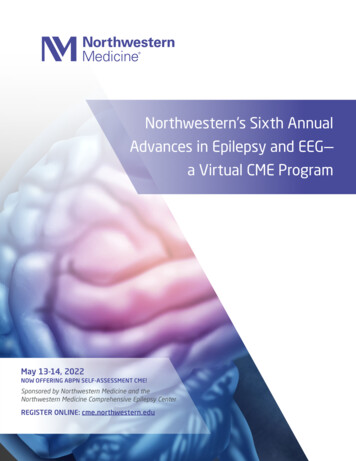

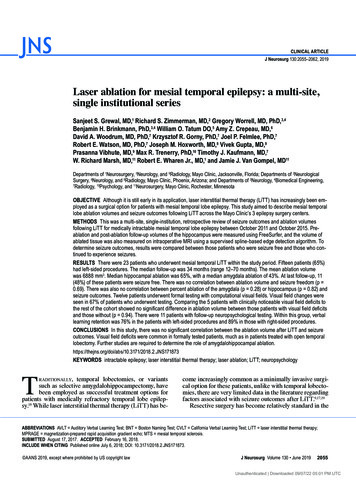
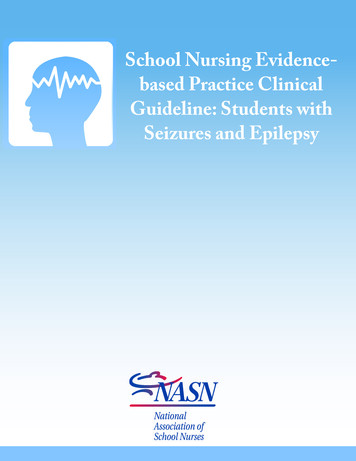
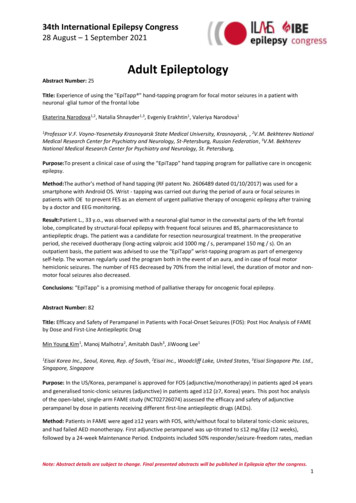
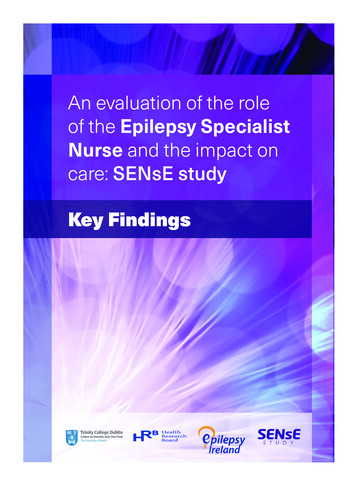

![Medical Training Initiative Post [Paediatric Neurology]](/img/35/cardiff-paediatric-neurology-mti-job-description-for-march-2020.jpg)
